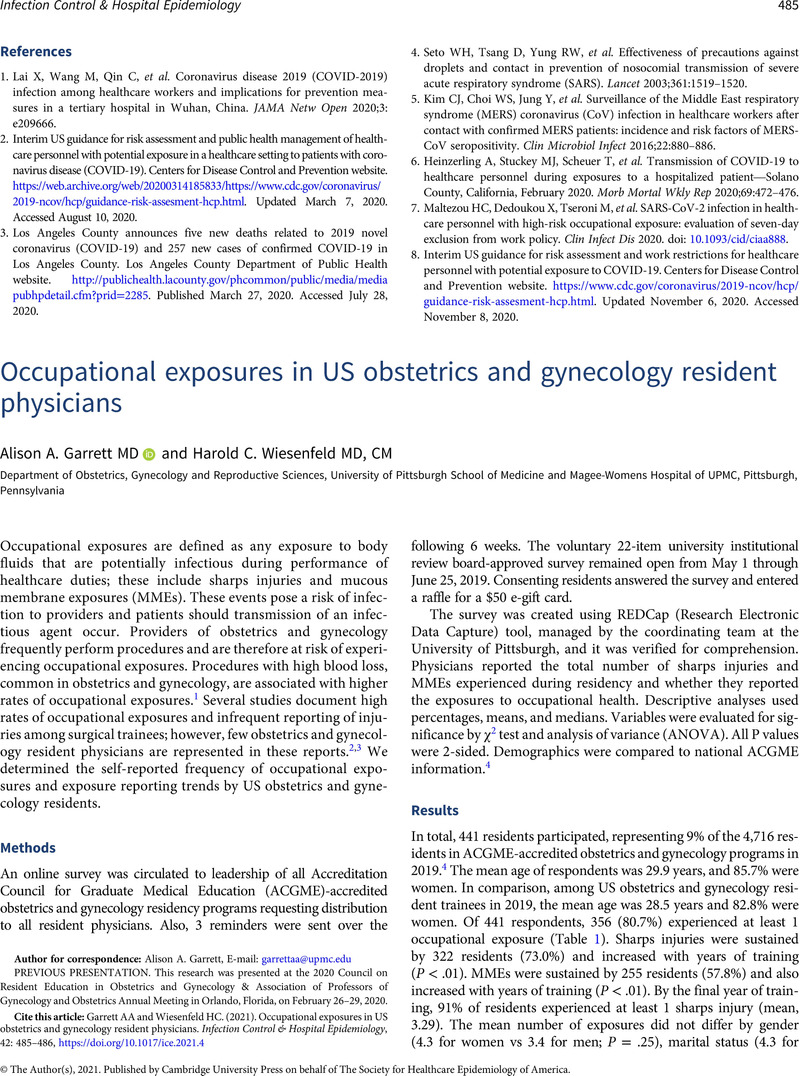No CrossRef data available.
Article contents
Occupational exposures in US obstetrics and gynecology resident physicians
Published online by Cambridge University Press: 11 February 2021
Abstract
An abstract is not available for this content so a preview has been provided. Please use the Get access link above for information on how to access this content.

- Type
- Research Brief
- Information
- Copyright
- © The Author(s), 2021. Published by Cambridge University Press on behalf of The Society for Healthcare Epidemiology of America
Footnotes
PREVIOUS PRESENTATION. This research was presented at the 2020 Council on Resident Education in Obstetrics and Gynecology & Association of Professors of Gynecology and Obstetrics Annual Meeting in Orlando, Florida, on February 26–29, 2020.
References
Myers, DJ, Epling, C, Dement, J, Hunt, D. Risk of sharp device-related blood and body fluid exposure in operating rooms. Infect Control Hosp Epidemiol 2008;29:1139–1148.CrossRefGoogle ScholarPubMed
Kessler, CS, McGuinn, M, Spec, A, Christensen, J, Baragi, R, Hershow, RC. Underreporting of blood and body fluid exposures among healthcare students and trainees in the acute care setting: a 2007 survey. Am J Infect Control 2011;39:129–134.CrossRefGoogle Scholar
Marnejon, T, Gemmel, D, Mulhern, K. Patterns of needlestick and sharps injuries among training residents. JAMA Intern Med 2016;176:251–252.CrossRefGoogle ScholarPubMed
ACGME Data Resource Book. Accreditation Council for Graduate Medical Education website. https://www.acgme.org/About-Us/Publications-and-Resources/Graduate-Medical-Education-Data-Resource-Book. Accessed January 14, 2020.Google Scholar
Choi, LY, Torres, R, Syed, S, et al. Sharps and needlestick injuries among medical students, surgical residents, faculty, and operating room staff at a single academic institution. J Surg Educ 2017;74:131–136.CrossRefGoogle Scholar
Drumhiller, K, Geter, A, Elmore, K, Gaul, Z, Sutton, MY. Perceptions of patient HIV risk by primary care providers in high-HIV prevalence areas in the southern United States. AIDS Patient Care STDS 2020;34:102–110.CrossRefGoogle ScholarPubMed
US Public Health Service. Updated US Public Health Service guidelines for the management of occupational exposures to HBV, HCV, and HIV and recommendations for postexposure prophylaxis. MMWR Recomm Rep 2001;50(RR-11):1–52.Google Scholar
Makary, MA, Al-Attar, A, Holzmueller, CG, et al. Needlestick injuries among surgeons in training. N Engl J Med 2007;356:2693–2699.CrossRefGoogle ScholarPubMed
Parantainen, A, Verbeek, JH, Lavoie, M-C, Pahwa, M. Blunt versus sharp suture needles for preventing percutaneous exposure incidents in surgical staff. Cochrane Database Syst Rev 2011;(11):CD009170.Google ScholarPubMed
Lancaster, C, Duff, P. Single versus double-gloving for obstetric and gynecologic procedures. Am J Obstet Gynecol 2007;196(5):e36–7.CrossRefGoogle ScholarPubMed



